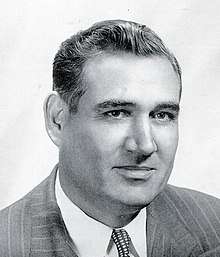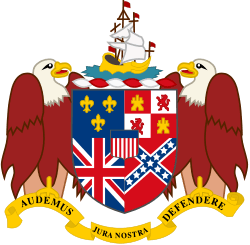Jim Folsom
James Elisha Folsom Sr. (October 9, 1908 – November 21, 1987), commonly known as Jim Folsom or Big Jim Folsom, was an American politician who served as the 42nd governor of the U.S. state of Alabama, having served from 1947 to 1951, and again from 1955 to 1959.
Jim Folsom | |
|---|---|
 | |
| 42nd Governor of Alabama | |
| In office January 17, 1955 – January 19, 1959 | |
| Lieutenant | William G. Hardwick |
| Preceded by | Gordon Persons |
| Succeeded by | John Malcolm Patterson |
| In office January 20, 1947 – January 15, 1951 | |
| Lieutenant | James C. Inzer |
| Preceded by | Chauncey Sparks |
| Succeeded by | Gordon Persons |
| Personal details | |
| Born | James Elisha Folsom October 9, 1908 Coffee County, Alabama, U.S. |
| Died | November 21, 1987 (aged 79) Cullman, Alabama, U.S. |
| Political party | Democratic |
| Spouse(s) | Sarah Carnley
( m. 1936; died 1944) |
| Children | 9 (including Jim) |
| Alma mater | University of Alabama Samford University George Washington University |
| Military service | |
| Allegiance | |
| Branch/service | United States Merchant Marine |
| Years of service | 1930-1933 |
Early life
Born in Coffee County in southeastern Alabama, Folsom was among the first southern governors to advocate a moderate position on integration and improvement of civil rights for African Americans. In his Christmas message on December 25, 1949, he said, "As long as the Negroes are held down by deprivation and lack of opportunity, the other poor people will be held down alongside them."[1]
After service in the US Merchant Marine in the early 1930s, Folsom became an insurance salesman. He attended the University of Alabama, Samford University in Birmingham, and George Washington University in Washington, DC, but he never obtained a college degree.
Before his gubernatorial campaigns, he won a race only once, as delegate to the 1944 Democratic National Convention. He was a strong supporter of keeping US Vice-President Henry A. Wallace on the ticket, rather than replacing him with Harry S. Truman of Missouri, which occurred.[2]
Governor
Folsom was elected governor for the first time in 1946. He waged a colorful campaign with a hillbilly band, brandishing a mop and bucket that he said would "clean out" the Capitol.
On March 3, 1948, Folsom's name was in headlines across the nation when the 30-year-old Christine Johnston, a widow who had met Folsom in late 1944 while she was working as a cashier at the Tutwiler Hotel in Birmingham, filed a paternity suit against the governor by alleging that he was the father of her 22-month-old son.[3] Undaunted, nine days after the suit was filed Folsom appeared on the sidewalk in front of the Barbizon Modeling School in New York City, where he kissed a hundred pretty models who had voted him "The Nation's Number One Leap Year Bachelor," attracting a crowd of 2500 onlookers and causing a traffic jam. Johnston dropped the suit in June for a cash settlement from Folsom; years later, he admitted to an interviewer that he was indeed the father of Johnston's child.[4]
On May 5, 1948, without prior publicity, Folsom married the 20-year-old Jamelle Moore, a secretary at the state Highway Department, whom he had met during his 1946 campaign and had been dating and seeing "almost daily" since then.[5]
However, despite the paternity suit and other scandals that arose during his administration, he was easily elected to a second non-consecutive term in 1954. The Alabama Constitution then forbade a governor from succeeding himself, a common provision in other southern states at the time. Folsom was 6'8" and employed the slogan "the little man's big friend."
In 1958, Folsom commuted a death sentence imposed on James E. Wilson, an African American sentenced to death for a $1.95 robbery. The Wilson case sparked international protests, but some segregationists called for Folsom not to commute the sentence.[6]
Folsom did not intervene in another controversial case; Jeremiah Reeves was electrocuted the same year, which also sparked protests.[7][8]
Two unsuccessful races
In 1962, Folsom again ran for governor against his one-time protégé George C. Wallace but he was defeated. A sardonic slogan emerged during that campaign that referred to Folsom's reputation for taking graft: "Something for everyone and a little bit for Big Jim." Folsom sometimes referred to "the emoluments of office" and once told a campaign crowd, "I plead guilty to stealing. That crowd I got it from, you had to steal it to get it.... I stole for you, and you, and you."[9]
Folsom's campaign was also damaged by a television appearance in which he appeared to have been seriously intoxicated and unable to remember his own children's names.[10] Both the appearance and the supposed "slogan" hurt him with the image-conscious middle class.
Folsom ran again for governor in 1966 and faced three other leading Democrats in the primary, former US Representative Carl Elliott, former Governor John Malcolm Patterson, and Attorney General Richmond Flowers Sr. However, the primary winner was none of those candidates but the surrogate for the outgoing Governor George Wallace: his first wife, Lurleen Burns Wallace. In the general election, Lurleen handily defeated the Republican nominee, James D. Martin, a one-term US representative from Gadsden.[11]
Folsom was never again elected to public office.
Later life
Folsom ran several times for public office but was not taken seriously by his political opponents. The former governor was plagued by ill health in the last years of his life. A 1976 article in People magazine reported that Folsom was legally blind, with only 5% vision, and nearly deaf.
Folsom died in 1987 in Cullman. His niece, Cornelia Wallace, the daughter of his sister, Ruby Folsom Ellis, was from 1971 to 1978 the second wife of his former rival, George Wallace.
A documentary film about Folsom Big Jim Folsom: The Two Faces of Populism, was produced in 1996 by the Alabama filmmaker Robert Clem and won the 1997 International Documentary Association/ABCNews VideoSource Award and the Southeastern Filmmaker Award at the 1997 Atlanta Film Festival.
In the 1997 TNT film George Wallace, directed by John Frankenheimer, Jim Folsom is played by Joe Don Baker, who was nominated for a CableACE award for his performance. Gary Sinise played Wallace.
Folsom's son James E. Folsom Jr. (dubbed "Little Jim," he is physically large because of his father's nickname) is also a noted Alabama politician. He served as lieutenant governor of Alabama from 1987 to 1993. He assumed the office of governor when Republican Governor Guy Hunt was removed from office after he had been convicted of state ethics law violations. Folsom Jr. ran for a full term as governor in 1994 but was defeated by Republican former Governor Fob James. He decided to re-enter state politics in 2006 and qualifies for and eventually won the lieutenant governor's position once again; he served from 2007 to 2011.
Folsom had nine children, two by his first wife, Sarah, and seven by his second wife, Jamelle Folsom. Folsom's first wife, the former Sarah Carnley, died in 1944 because of pregnancy complications.[12][13] Folsom eloped and married his second wife, former First Lady of Alabama Jamelle Folsom, in 1948.[13] They remained married until his death.[13]
References
- Specific
- New York Times, May 4, 1974
- , Time magazine
- "Unwed Mother Sues Gov. Folsom of Alabama; Tells Affair". Chicago Daily Tribune. March 3, 1948. Retrieved 14 November 2014.
- Grafton, Carl; Permaloff, Anne (1985). Big Mules and Branchheads: James E. Folsom and Political Power in Alabama (Paperback, 2008 ed.). Athens, Georgia: University of Georgia Press. pp. 113–114. ISBN 0820331880. Retrieved 14 November 2014.
- Hammond, Ralph (January 18, 1955). "Jim and Jamelle - a Love Story". The Gadsden Times (Inaugural Edition). Retrieved 14 November 2014.
- Jet, October 9, 1958 issue
- Virginia Foster Durr, Patricia Sullivan, Freedom Writer: Virginia Foster Durr, Letters from the Civil Rights Years, Routledge, 2003, ISBN 0-415-94516-X, 9780415945165
- Jet. April 10, 1958 issue
- Grafton, Carl; Permaloff, Anne (1 September 2008). Big Mules and Branchheads: James E. Folsom and Political Power in Alabama. University of Georgia Press. p. 170. ISBN 9780820331881.
- "George Wallace". The Telegraph. 15 September 1998.
- Billy Hathorn, "A Dozen Years in the Political Wilderness: The Alabama Republican Party, 1966-1978", Gulf Coast Historical Review, Vol. 9, No. 2 (Spring 1994), p. 22, 28
- Bullard, Benjamin (2012-11-30). "Former first lady Jamelle Folsom remembered (Updated with 2004 Times interview)". Cullman Times. Archived from the original on 2013-01-10. Retrieved 2012-12-30.
- "Former Ala. first lady Jamelle Folsom dies at 85". Associated Press. Montgomery Advertiser. 2012-12-02. Retrieved 2012-12-30.
- General
- Alabama Governor James Folsom (Alabama Department of Archives and History
- Encyclopedia of Alabama article
- Oral History Interview with James Folsom from Oral Histories of the American South
| Party political offices | ||
|---|---|---|
| Preceded by Chauncey Sparks |
Democratic nominee for Governor of Alabama 1946 |
Succeeded by Gordon Persons |
| Preceded by Gordon Persons |
Democratic nominee for Governor of Alabama 1954 |
Succeeded by John Malcolm Patterson |
| Political offices | ||
| Preceded by Chauncey Sparks |
Governor of Alabama 1947–1951 |
Succeeded by Gordon Persons |
| Preceded by Gordon Persons |
Governor of Alabama 1955–1959 |
Succeeded by John Malcolm Patterson |
